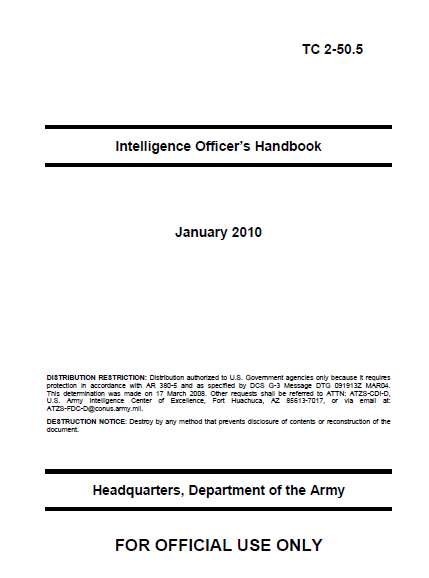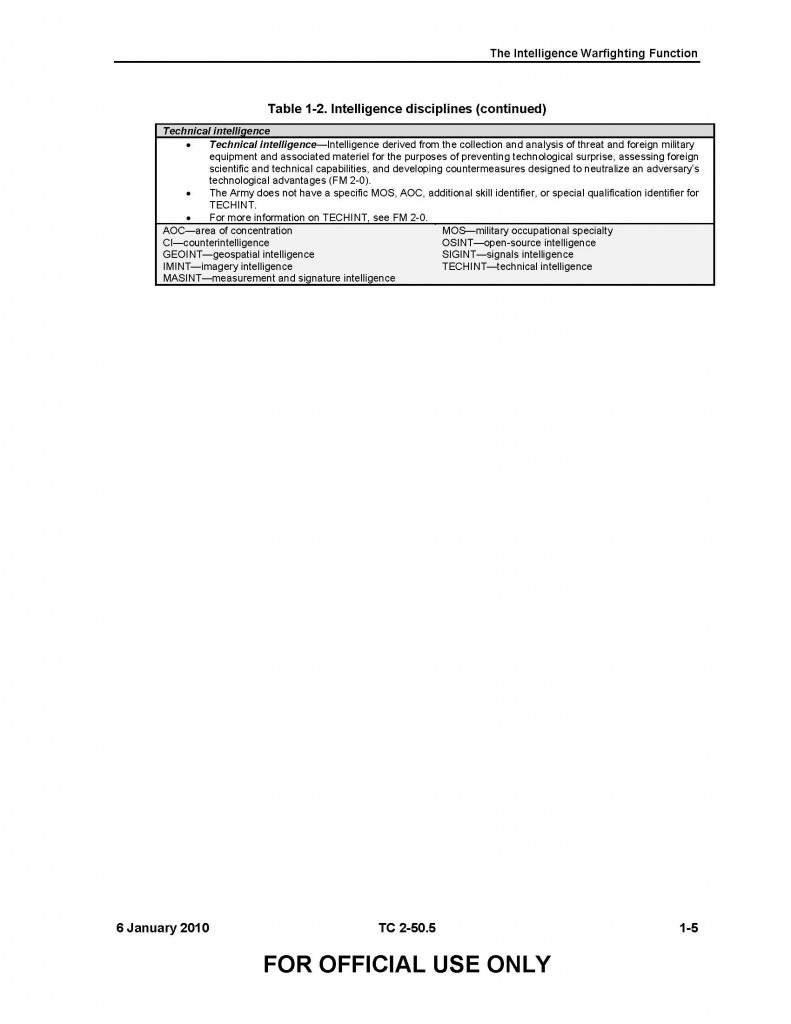TC 2-50.5: Intelligence Officer’s Handbook
- 168 pages
- For Official Use Only
- January 2010
- 6.56 MB
OVERVIEW
1-1. The intelligence warfighting function is one of six warfighting functions. A warfighting function is a group of tasks and systems (people, organizations, information, and processes) united by a common purpose that commanders use to accomplish missions and training objectives (FM 3-0).
1-2. The intelligence warfighting function is the related tasks and systems that facilitate understanding of the operational environment. It includes tasks associated with intelligence, surveillance, and reconnaissance operations and is driven by the commander (FM 3-0). Intelligence is more than just collection; it is a continuous process that involves analyzing information from all sources and conducting operations to develop the situation. The intelligence warfighting function includes the following tasks:
• Support to force generation.
• Support to situational understanding.
• Conduct intelligence, surveillance, and reconnaissance (ISR).
• Provide intelligence support to targeting and information superiority.…
INTELLIGENCE CATEGORIES
1-6. As discussed in FM 2-0, Army unit intelligence staffs produce and receive, directly or indirectly, six categories of intelligence support from the U.S. intelligence community. Intelligence categories are distinguishable primarily by their intelligence product purposes. The categories can overlap and the same intelligence can be used in each category. Intelligence organizations use specialized procedures to develop these categories. The following information describes each category and the responsible organization:
• Indications and warning (I&W). Analysis of time-sensitive information that could involve a threat to U.S. and multinational military forces, U.S. political or economic interests, or to U.S. citizens. While the G-2/S-2 produces I&W intelligence, every Soldier, such as the one conducting a presence patrol, contributes to the I&W through awareness of the CCIRs and by reporting related information.
• Current intelligence. The G-2/S-2 produces accurate reporting on the current threat situation— which becomes a portion of the common operational picture (COP)—projects the threat’s anticipated situation and the implication to friendly operations.
• General military intelligence (GMI). GMI focuses on the military capabilities of foreign countries, organizations, or on topics relating to Armed Forces capabilities, including threat characteristics (previously order of battle factors) and area or terrain intelligence. The G-2/S-2 develops initial intelligence preparation of the battlefield (IPB) products from various GMI databases, and then develops and maintains the unit’s GMI database on potential threat forces and areas of concern based on the commander’s guidance. This database supports the unit’s plan, preparation, execution, and assessment of operations.
• Target intelligence. The analysis of threat units, dispositions, facilities, and systems to identify and nominate specific assets or vulnerabilities for attack, reattack, or exploit.
• Scientific and technical intelligence (S&TI). The collection, evaluation, and interpretation of foreign engineering science and technology with warfare potential, including military systems, weapons, weapons systems, materiel, research and development, and production methods. The G-2/S-2 establishes instructions in standing operating procedures (SOPs), orders, and plans for handling and evacuating captured enemy material for S&TI exploitation.
• Counterintelligence (CI). Identifying and recommending countermeasures against threats by foreign intelligence services and the ISR activities of nonstate entities, such as organized crime, terrorist groups, and drug traffickers.INTELLIGENCE DISCIPLINES
1-7. Intelligence disciplines are categories of intelligence functions. There are nine major intelligence disciplines:
• All-source intelligence.
• CI.
• Human intelligence (HUMINT).
• Geospatial intelligence (GEOINT).
• Imagery intelligence (IMINT).
• Measurement and signature intelligence (MASINT).
• Open-source intelligence (OSINT).
• Signals intelligence (SIGINT).
• Technical intelligence (TECHINT).…



